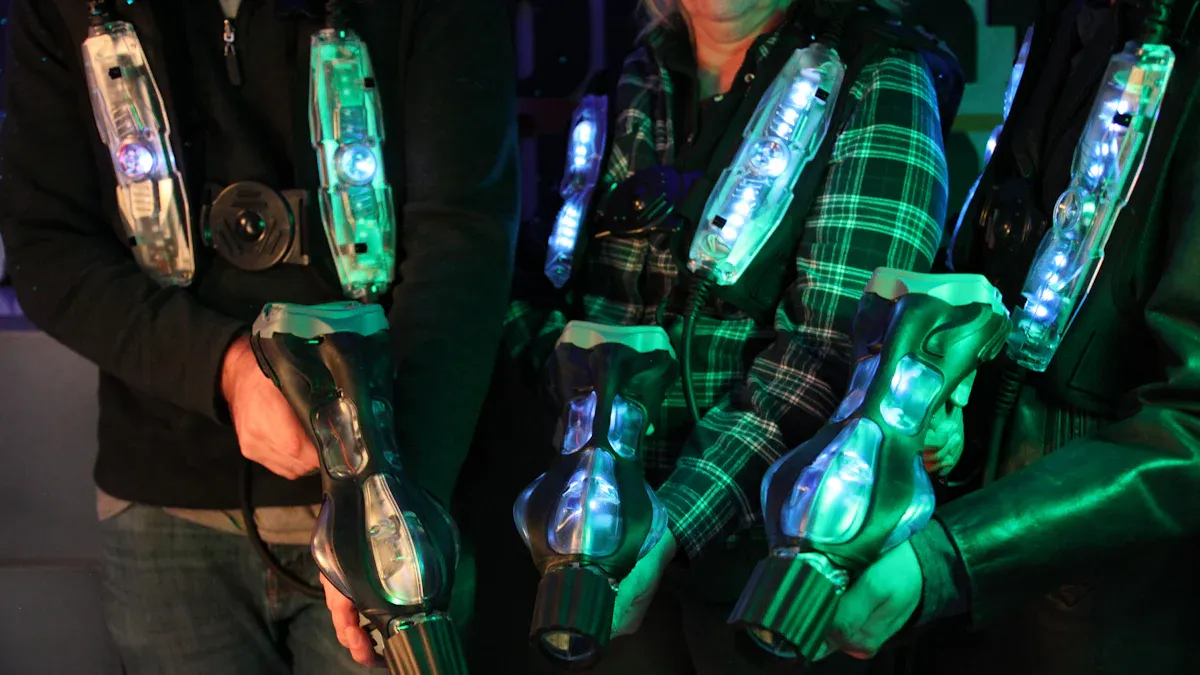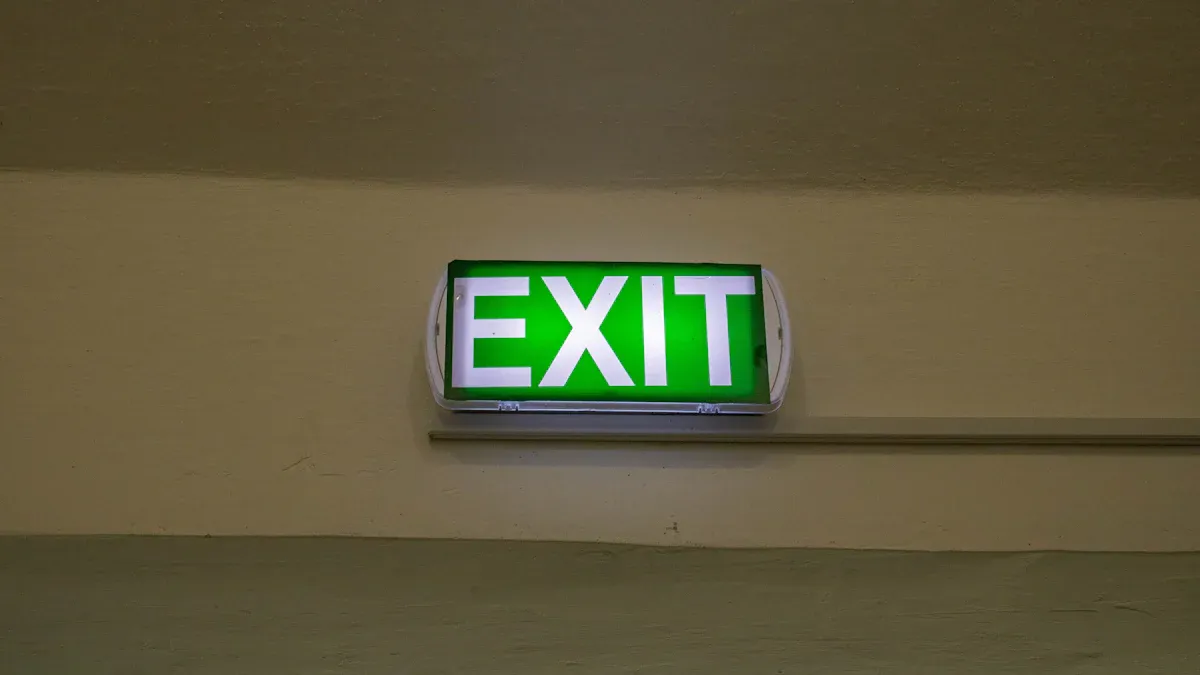How to Use Flashlights Effectively During Power Failures

Power outages can strike unexpectedly, leaving you in complete darkness. Flashlights offer a life-saving power during these moments. They illuminate your surroundings, ensuring safety and comfort. For instance:
Hikers in the Appalachian Mountains used a flashlight to signal for rescue.
A motorist signaled for help after a breakdown at night.
Reliable illumination can make all the difference.
Key Takeaways
Flashlights give steady light during blackouts, keeping you safe in the dark.
Pick strong, waterproof flashlights with brightness settings to save battery power.
Check your flashlights often and store extra batteries for emergencies.
Benefits of Flashlights During Power Outages

Reliable Illumination for Emergencies
A flashlight is an essential tool during emergencies, offering critical illumination when you need it most. Unlike candles or lanterns, flashlights provide focused light, making it easier to see specific areas or objects. This feature proves invaluable in survival scenarios, such as locating supplies or navigating through dark spaces. Many models, including tactical flashlights, come equipped with strobe or SOS functions, which can signal for help during a natural disaster or other emergencies. Their portability and lightweight design make them a reliable addition to any emergency preparedness kit.
A reliable flashlight ensures visibility during rescue operations, even in harsh weather conditions. Its long-lasting battery life prevents you from being left in the dark during extended outages, highlighting the life-saving potential of this tool.
Enhancing Safety and Preventing Accidents
Power outages can turn your home into a hazardous environment. Without proper lighting, you risk tripping over furniture, slipping on wet surfaces, or stepping on sharp objects. Flashlights help you avoid these dangers by illuminating your path and surroundings. Their focused beam allows you to identify obstacles and move confidently, ensuring the safety of everyone in your household.
Flashlights are also indispensable for first aid. They provide the light needed to treat injuries or locate medical supplies in the dark. A tactical flashlight, with its durable and water-resistant design, can be a dependable tool in disaster situations, further enhancing your safety.
Providing Comfort During Power Failures
The psychological impact of a power outage can be significant, especially during prolonged periods of darkness. Flashlights offer more than just light; they provide comfort and reassurance. Their presence helps you regain control over your environment, reducing anxiety and fear. This is particularly important for vulnerable individuals, such as children or the elderly, who may feel unsettled in unfamiliar situations.
Flashlights create a sense of calm by offering reliable light, helping you and your loved ones feel secure during challenging times. Their role in maintaining emotional well-being underscores the importance of flashlights in any survival scenario.
Practical Tips for Using Flashlights Effectively
Conserve Battery Life with Smart Usage
Maximizing the lifespan of your flashlight’s battery is crucial during extended power outages. You can take several steps to ensure your flashlight remains operational when you need it most:
Invest in high-quality batteries specifically designed for flashlights. These batteries offer better performance and durability.
Store batteries in a cool, dry place to prevent corrosion and maintain their effectiveness.
Remove rechargeable batteries from the flashlight during long-term storage to avoid unintentional drainage.
Use a reliable battery charger that automatically selects the correct charging mode.
Avoid overcharging or exposing batteries to extreme temperatures, as this can reduce their lifespan.
💡 Tip: Use your flashlight sparingly during a power outage. Turn it off when not in use to conserve energy and ensure long battery life.
Use Adjustable Brightness Modes
Flashlights with adjustable brightness modes provide flexibility and efficiency. These modes allow you to adapt the light output to specific situations, whether you need a dim light for close-up tasks or a bright beam for outdoor navigation. By using lower brightness settings when possible, you can conserve battery life and prolong the flashlight’s usability.
Tactical flashlights often feature multiple brightness levels, making them ideal for survival scenarios. For example:
Use the highest setting to illuminate dark pathways or signal for help during an emergency.
Switch to a medium or low setting for routine tasks to save energy.
This adaptability ensures your flashlight remains effective in various contexts, from everyday use to disaster preparedness.
Position Flashlights for Maximum Efficiency
Proper positioning of your flashlight enhances its effectiveness and ensures safety during power outages. Place the flashlight in a central location to illuminate the largest area possible. For hands-free lighting, consider using a headlamp or mounting the flashlight on a stable surface.
Tactical flashlights often come with features like clips or magnetic bases, allowing you to secure them in convenient positions. This is particularly useful in survival scenarios where you need both hands free for other tasks.
🔦 Pro Tip: Use reflective surfaces, such as mirrors or aluminum foil, to amplify the light and brighten larger spaces. This technique can help conserve battery life while maximizing illumination.
Choosing the Right Flashlight for Emergencies

Essential Features for Power Outages
When selecting a flashlight for emergencies, you should prioritize specific features to ensure reliability during critical moments. A durable and weather-resistant design is essential for withstanding impacts and harsh conditions. Long battery life is another key factor, as it ensures continuous illumination during extended outages. Flashlights with multi-functional capabilities, such as strobe modes or built-in chargers, offer added versatility.
Some models even include signaling features like solar-powered or hand-crank options, which can be lifesaving in survival scenarios. Adjustable brightness levels also enhance usability, allowing you to adapt the light output to different tasks. These features make a tactical flashlight an indispensable tool for disaster preparedness.
💡 Tip: Look for flashlights with a compact design and ergonomic grip for ease of use during emergencies.
Rechargeable vs. Battery-Powered Flashlights
Choosing between rechargeable and battery-powered flashlights depends on your needs. Rechargeable flashlights offer higher power capacity, making them ideal for high-drain situations. They also provide long-term cost savings and are more environmentally friendly due to their extended lifespan. However, they require electricity for charging, which can be a limitation during power outages.
Battery-powered flashlights, on the other hand, are often more compact and portable. They rely on replaceable batteries, making them convenient for survival scenarios where electricity may not be available. While rechargeable models have higher upfront costs, their performance and eco-friendliness make them a worthwhile investment for frequent use.
Feature | Rechargeable Flashlights | Battery-Powered Flashlights |
|---|---|---|
Power Capacity | High | Moderate |
Portability | Bulkier | Compact |
Cost | Higher upfront | Lower upfront |
Environmental Impact | Eco-friendly | Less eco-friendly |
Durable and Water-Resistant Options
In extreme conditions, a durable and water-resistant flashlight becomes a necessity. These flashlights are designed to perform reliably in severe weather, including heavy rain and freezing temperatures. Their weather-resistant materials ensure they can withstand harsh environments without compromising functionality.
Tactical flashlights often feature extended battery life, making them suitable for prolonged use during emergencies. Their rugged construction also makes them ideal for survival scenarios, where dependable lighting is crucial. Whether you’re navigating through a storm or dealing with a disaster, these flashlights provide the reliability you need.
🔦 Pro Tip: Opt for a tactical flashlight with a water-resistance rating of IPX7 or higher for optimal performance in wet conditions.
Preparing and Maintaining Flashlights for Power Outages
Keep Spare Batteries and Accessories Ready
Having spare batteries ensures your flashlight remains operational during extended power outages. You should stock up on reliable options to avoid being caught unprepared. Rechargeable NiMH batteries, such as Eneloops, are excellent for their durability and energy efficiency. Alkaline batteries can also serve as a backup, especially in low-power modes, where they can last for hours even when partially drained. For added preparedness, consider keeping an AAA flashlight. This compact option can be a lifesaver when other battery types are unavailable during a disaster.
🔋 Tip: Store extra batteries in a cool, dry place to maintain their longevity and prevent corrosion.
Store Flashlights in Accessible Locations
Strategically placing flashlights throughout your home ensures quick access during emergencies. Keep at least one flashlight in every major room, including bedrooms, the kitchen, and the living room. Storing extras in your emergency kit and car adds another layer of preparedness. This practice minimizes the time spent searching for light sources when the power goes out.
Regularly inspect your emergency supplies to ensure everything is in working order. Replace batteries in flashlights as needed to avoid surprises during critical moments.
🏠 Pro Tip: Use labeled containers or designated drawers to store flashlights and accessories. This organization helps you locate them quickly when needed.
Regularly Test Flashlights for Functionality
Testing your flashlights periodically ensures they remain reliable. Turn them on to check the brightness and battery life. Inspect the casing for signs of wear or damage, especially in tactical flashlights, which are often exposed to harsh conditions. Replace worn-out parts or batteries immediately to maintain optimal performance.
Tactical flashlights, known for their durability, require regular maintenance to stay effective. Clean the lens and contacts to prevent dirt buildup, which can reduce light output. By staying proactive, you can rely on your flashlight during any emergency.
🔦 Note: Schedule a monthly check for all your flashlights to ensure they are ready for use at any time.
Using flashlights effectively during power outages ensures safety, comfort, and preparedness. Choose durable, water-resistant models with adjustable brightness and long runtime. Stock high-quality batteries and test flashlights regularly. Include a tactical flashlight in your emergency kit for reliability. These steps help you stay ready for unexpected situations and maintain peace of mind.
FAQ
What type of flashlight is best for power outages?
Choose a durable, water-resistant flashlight with long battery life. Models with adjustable brightness and emergency features like SOS modes are ideal for extended outages.
How often should you test your flashlights?
Test your flashlights monthly. Check brightness, battery life, and casing for damage. Replace batteries or worn parts immediately to ensure reliability during emergencies.
Can rechargeable flashlights work during prolonged outages?
Yes, but only if pre-charged. Keep a backup power source like a portable charger or solar panel to recharge them during extended power failures.
💡 Tip: Always store spare batteries or a secondary flashlight to stay prepared for unexpected situations.
See Also
Key Strategies for Keeping Your Flashlight in Top Shape
A Homeowner's Guide to Selecting the Ideal Emergency Flashlight
Maximize Your Flashlight's Battery Life with These Simple Tips
Our Emergency Flashlight: Designed for Exceptional Durability and Longevity
Why Rechargeable Flashlights Are Essential for Community Safety
